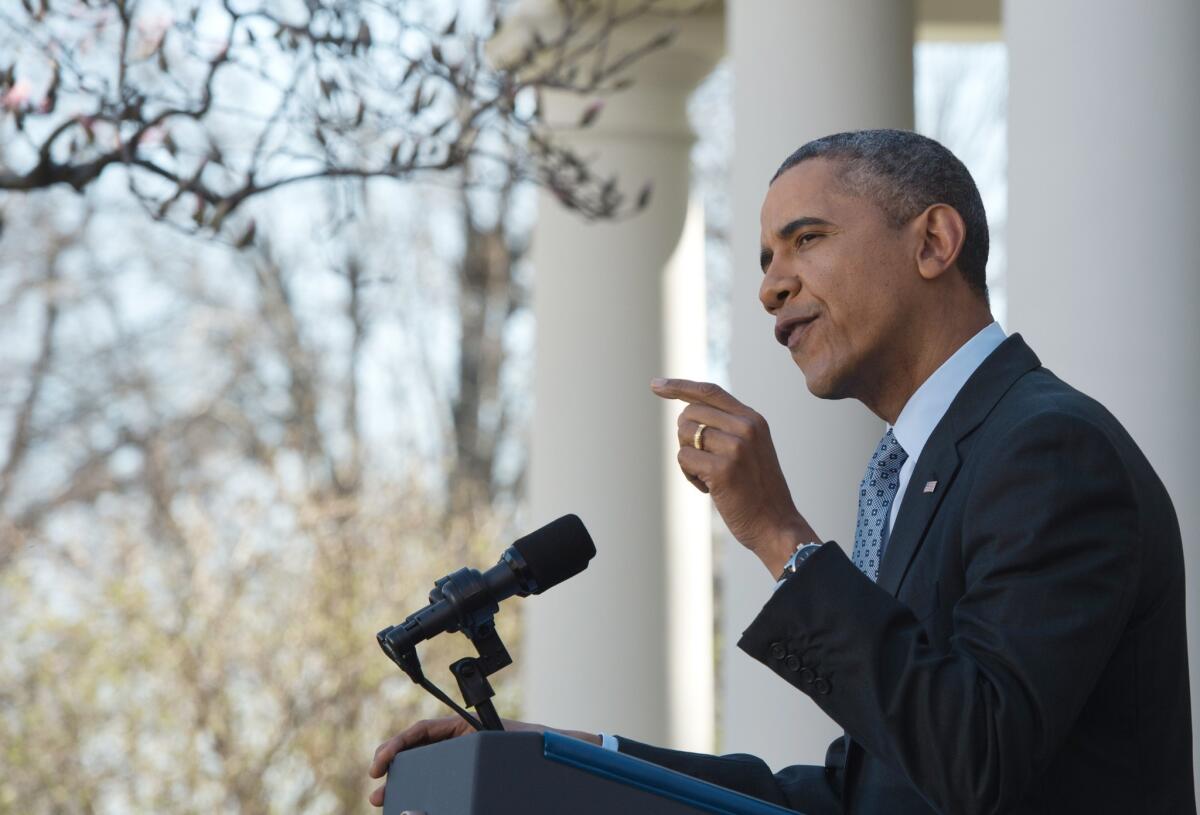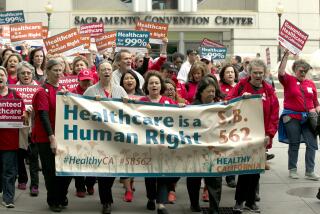Divide between red and blue states over healthcare deepens

- Share via
Reporting from Washington — States that have aggressively put the Affordable Care Act into practice have cut the number of uninsured residents sharply -- in some cases in half or better -- while those that balked have improved little if at all, according to new data released Tuesday.
The state-by-state numbers, from the Gallup-Healthways Well-Being Index, reinforce one of the major impacts of Obamacare so far: Political debate has widened the healthcare gap between red and blue states.
All 10 states with the largest percentages of uninsured adults now have Republican governors and legislatures. The lowest percentages all are governed by Democrats, with the exception of Pennsylvania.
The 10 states with the biggest improvement in insurance coverage all took two major steps to implement the healthcare law -- they expanded Medicaid coverage, as the law allows, and they either set up their own online marketplace to let residents buy insurance or they entered into a partnership with the federal government to create one.
By contrast, the states that still have the highest percentages of uninsured residents all declined to expand Medicaid and refused to participate in creating the online exchanges, leaving that task to Washington. Some states went further this year and actively impeded the exchanges, forbidding state employees to provide information about them, for example.
Gallup’s results have been carefully followed in the healthcare debate because they are based on a huge number of survey interviews -- 88,678 for this year’s data. That allows analysis of changes at the state level as well as different demographic groups. Government figures from census surveys will not be available for many months.
Nationwide, 18% of Americans lacked insurance last year just before the healthcare law took effect, while 13.4% were uninsured in the second quarter of this year, according to Gallup’s surveys.
Arkansas and Kentucky, both states that began with large numbers of uninsured residents, showed the biggest improvements. In Arkansas, the percentage of residents without insurance dropped from 22.5% last year -- significantly above the national average -- to 12.4% at the middle of this year. Kentucky improved from 20.4% uninsured to 11.9%.
California had the largest drop in the sheer number of people lacking insurance; its percentage decrease ranked 8th nationally, from 21.6% last year to 16.3% at midyear.
At the other end of the scale, Texas had the highest percentage of uninsured residents last year -- nearly 3 in 10 -- and still does. The share of uninsured Texans dropped by only 3 points, to 24% of the state’s adult population.
Last year, 14 states had one-fifth or more of the adult population lacking insurance. As of midyear, only three states remained in that group, with Georgia and Mississippi joining Texas. Florida and Louisiana were close behind.
All five of those states are among the 21 that have ruled out expansion of Medicaid to all adults at or near the poverty level. The law allows that expansion and provides for the federal government to pick up the entire cost for the first several years and the lion’s share thereafter.
Republican governors in Utah, Indiana and Pennsylvania continue to negotiate with the federal government over expansion plans, while 26 states have expanded their programs.
Opponents of expansion argue that Washington eventually will dump the cost on the states; some also oppose Medicaid entirely on ideological grounds.
In addition to Arkansas, Kentucky and California, the 10 states with the biggest drop in the percentage of uninsured adults included Delaware, Washington, Colorado, West Virginia, Oregon, New Mexico and Connecticut.
Some of those states -- most notably Oregon -- had considerable trouble with their state-run insurance marketplaces but succeeded in enrolling significant numbers of their residents anyway.
The data show that “effectively implementing needed reforms makes a huge difference in getting people insured so they can get the health care they need,” Washington Gov. Jay Inslee said in a statement. The state enrolled roughly 600,000 residents under the Affordable Care Act.
For more news on politics and policy, follow me on Twitter @DavidLauter
More to Read
Sign up for Essential California
The most important California stories and recommendations in your inbox every morning.
You may occasionally receive promotional content from the Los Angeles Times.











